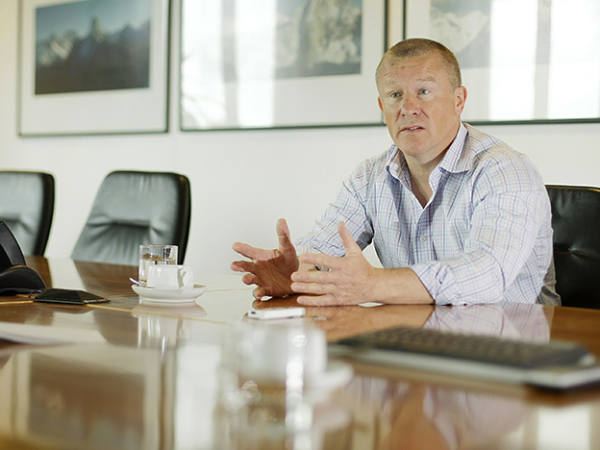Concerns about the bond market and the possibility of rate rises later this year have caused investors to look at alternative options for income such as equity income and commercial property. Commercial property had a very good run in 2014, and some predict that the asset class will continue to do well.
"The fundamentals for UK commercial property suggest returns from the asset class could exceed 10 per cent for a third consecutive year in 2015," says Andy Brunner, investment strategist at Morningstar OBSR. "Commercial property offers a very high starting yield, the prospect of solid capital growth and a pick-up in rental growth in the year ahead. Overall, the economic environment should remain favourable for commercial property with the asset class supported by high levels of income together with capital value and rental growth. Current forecasts of 9 to 10 per cent total returns for 2015 could well be revised higher as the year progresses."
Mr Brunner says there is very little high-grade property currently available with few developments in the pipeline from 2015 through to 2017 in London. "The consequence is that rents will continue rising over the next few years given ongoing supply constraints," he says. "Opportunities outside of London persist and we expect further capital value growth in 2015. There is a shortage of high-quality prime space in the regions, where the availability of grade A stock has fallen by nearly 40 per cent over the last four years or so. This shortage should continue through 2015, despite an additional 5m sq ft of grade A development coming onto the market over the next several years."
Private investors cannot directly buy into commercial property because of the millions of pounds it involves to buy buildings, rather they have to invest via funds. However, research by broker Hargreaves Lansdown shows that the average open-ended property fund has failed to beat the IPD UK All Property Monthly TR Index over one, three, five and 10 years to 31 December 2014. No individual funds beat the index over 10 years. By contrast, over three and five years funds that invest in property shares rather than direct property funds tended to beat the IPD index.
| 1-year total return (%) | 3-year cumulative total return (%) | 5-year cumulative total return (%) | 10-year cumulative total return (%) | |
| IA Property sector average | 12.5 | 31.0 | 39.1 | 36.0 |
| IPD UK All Property Monthly TR | 17.4 | 33.3 | 65.0 | 73.2 |
Source: Lipper/Hargreaves Lansdown, as at 31 December 2014
"The reason for the underperformance of open-ended property funds is not simply poor investment choices made by active managers, but partly the tax paid by some funds, and the high costs of investing in commercial property, which detract from returns," says Laith Khalaf, senior analyst at Hargreaves Lansdown. "These costs are over and above the annual fund management charge levied by the investment manager."
Such costs include:
• stamp duty on purchase;
• legal fees on purchase and sale;
• estate agency/property consultancy fees on purchase and sale;
• ongoing property maintenance/ refurbishment charges; and
• vacancy periods.
"The cost of trading and ownership exists for any fund, but it is much more onerous for property than other asset classes like shares and bonds," adds Mr Khalaf.
Property unit trusts also pay 20 per cent tax on income, which cannot be reclaimed even if you hold it in a tax-efficient wrapper such as an individual savings account (Isa) or a self-invested personal pension (Sipp), or are a non-taxpayer. However, in 2008 a new structure was introduced, Property Authorised Investment Funds (Paif), which distribute their income gross. This means investors should be able to benefit from holding the fund in a tax wrapper such as a Sipp or Isa and get higher returns. A number of property funds have converted to this structure, although not many fund platforms can host them. Platforms that do host Paifs include Alliance Trust Savings (www.alliancetrustsavings.co.uk) and Hargreaves Lansdown (www.hl.co.uk).
Mr Khalaf also points out that over 10 years to 31 October 2014 the property sector ranks 30 out of 33 Investment Association sectors, albeit still with a positive return of 45 per cent.
Cash issues
Another drag on open-ended property fund returns is cash, as many of these hold it in case they need to meet investor redemptions. Large commercial properties are not easy to buy and sell, and in 2008 when many investors wished to take their money out of commercial property funds they could not do so immediately, because the funds did not have the money to reimburse them.
Since then funds have taken steps to mitigate this risk, holding cash so they can give investors money back if they want to withdraw from the fund. But this can detract from returns relative to the benchmark when this is rising.
And not everyone is bullish on the prospects for UK commercial property.
David Coombs, head of multi-asset investments at Rathbones, does not believe UK commercial property is a good value. He says that secondary property markets are more highly correlated to equities so that it is not necessarily a good diversifier. "This is owing to the fact that their occupancy and rents are more linked to the economic cycle," he says. "Tenants tend to be smaller businesses - regional retail and industrials are clearly cyclical. Think of the number of shopping chains entering administration since 2008 - there is no shortage of regional offices and industrial parks. Hotels are also cyclical. This is in contrast with London's West End, where supply is very limited."
He would only invest selectively, for example, in funds which provide access to distribution. He likes Tritax Big Box Reit (BBOX) which invests in logistics assets.
Tritax's managers believe that a significant opportunity exists in the UK logistics market, owing to strong tenant demand in high growth areas of the economy, as well as limited stock supply.
However, Tritax Big Box Reit trades on a premium to net asset value (NAV) of 6 per cent. Note that this fund launched at the end of 2013 so does not have a long track record.
Simon Molica, senior investment consultant and portfolio manager at Morningstar Investment Management, says last year would have been a better time to enter commercial property. "UK commercial property seems an attractive area with strong yields but be careful of how strong it has been," he says. "It is not likely to be as strong as in 2014 and risks are emerging."
Rob Pemberton, investment director at HFM Columbus says: "The risk for the asset class fundamentally is that it is now starting to look fully valued as the yield on the UK All Property Index has compressed to around 5.7 per cent, below its long-term average. Should the UK economy suddenly hit the buffers or the banks decide to rein in their lending again then commercial prices would certainly stall and probably begin to fall."
Mr Brunner adds: "The main risk to the asset class comes from its dependency on the health of the UK economy; the recovery has been instrumental in generating increasingly positive occupier confidence over the past 18 months.
"The May general election could create a period of uncertainty leading to some deferral of purchases by both domestic and overseas investors."
Reasons to allocate
However, some argue that there is still a place for property funds in your portfolio. Mike Horseman, managing director of financial adviser Cockburn Lucas, says given the attractive yields available commercial property is an area investors would do well to look at as part of a multi-asset allocation.
Even if UK property funds are not beating the IPD index, bricks and mortar funds in particular can still be a way to diversify your portfolio.
"Commercial property assets add diversification to a portfolio as they have a different returns cycle to those of equities and fixed income assets," says Mr Pemberton. "Commercial property typically is an asset class with low volatility, a consistent pattern of returns and a strong income stream with the majority of the return coming from rental income rather than capital growth."
Caroline Shaw, fund manager at Courtiers Asset Management, says if you do invest in commercial property then you should be prepared not to need the money back at a particular time and have a long-term horizon for investment.
Mr Khalaf says that investors should be relatively sophisticated with large well diversified portfolios who want extra diversification, and or to boost income. He suggests that you do not put more than 5 to 10 per cent of your portfolio into this asset.
Property fund options
Open-ended direct property funds have not beaten the IPD index but can still offer attractive yields and positive returns. We count M&G Property Portfolio (GB00B89X8P64) among our IC Top 100 Funds and the Paif share classes are available on platforms including Hargreaves Lansdown Vantage and Alliance Trust Savings, offering a yield of nearly 4 per cent.
Alternatives to UK open-ended bricks and mortar funds include property securities funds, and investment trust and real estate investment trusts (Reits) invested in both direct property and securities such as equities. However, funds that invest in equities provide less diversification: even if commercial property is doing well but equities markets fall, these funds' assets are likely to move more in line with equity markets.
Mr Horseman recommends you buy a globally diversified fund which offers exposure to both securities and direct property, and maybe hold this alongside investment trusts and Reits. He suggests HSBC Open Global Property Fund (GB00B702WG47) which invests in funds that are exposed to both direct and listed property markets, as well as cash and liquidity funds. The fund has an ongoing charge of 1.35 per cent and yields 2.03 per cent. It is available on platforms including Alliance Trust Savings.
| 1-year total return (%) | 3-year cumulative total return (%) | 5-year cumulative total return (%) | 10-year cumulative total return (%) | |
| HSBC Open Global Property Retail Acc | 18.6 | 40.3 | 52.6 | na |
| M&G Property Portfolio A GBP Inc* | 13.4 | 20.5 | 32.8 | |
| IA Property sector average | 14.3 | 35.7 | 43.4 | 41.2 |
| FTSE All Share TR GBP | 1.5 | 35.5 | 48.2 | 106.1 |
Source: Morningstar, as at 8 January 2015
*This performance data is based on an older share class as this fund only converted to a PAIF on 18 January 2013.
A number of investment trusts focus on UK direct property. However, most of these trade at high premiums to NAV due to their attractive yields so you are paying more for the shares than the assets are worth. These include IC Top 100 Funds F&C Commercial Property (FCPT), UK Commercial Property (UKCM) and Picton Property Income (PCTN).
F&C Commercial Property and UK Commercial Property look the most expensive of these. They are both trading at double digit premiums to their underlying net asset value (NAV), and at higher levels than their 12-month average premiums.
Picton Property Income looks more reasonably priced. It is trading at a 6 per cent premium to NAV, in line with its 12-month average. It has not performed as strongly as the other funds over three and five years, but beats them over one year, and offers an attractive yield of about 4.5 per cent. Analysts at Oriel believe the outlook for the trust's diverse portfolio remains positive, with capital growth now appearing in regional markets.
We also count TR Property (TRY) among our IC Top 100 Funds. This holds mainly shares in UK and European listed property companies, but also has about 7 per cent of its assets in UK direct property. The trust has done well beating its benchmark, FTSE EPRA/NAREIT Developed Europe Capped TR Net GBP, over one, three and five years, and is on a discount to NAV of 1.5 per cent, albeit tighter than its 12-month average of about 2.3 per cent.
| Trust | Yield (%) | 1-year share price return (%) | 3-year share price cumulative return (%) | 5-year share price cumulative return (%) | Premium/discount to NAV (%) | Ongoing charge (%) |
| Tritax Big Box | 3.81 | 9.8 | n/a | n/a | +7.8 | na |
| F&C Commercial Property | 4.29 | 20.7 | 59.8 | 97.8 | +19.5 | 1.74 |
| UK Commercial Property | 4.07 | 22.0 | 57.2 | 55.9 | 12.9 | 1.9 |
| Picton Property Income | 4.51 | 22.5 | 120.9 | 76.4 | 6.2 | 3.09 |
| MSCI ACWI/Real Estate GR USD | 27.2 | 58.8 | 76.1 | |||
| FTSE All Share TR GBP | 0.9 | 35.0 | 46.8 | |||
| TR Property | 2.65 | 27.6 | 130.3 | 118.0 | -1.4 | 2.06 |
| FTSE EPRA/NAREIT Developed Europe NR USD | 19.4 | 75.5 | 63.2 |
Source: Morningstar, as at 9 January 2015










